364. The Explorers stayed for 5 days in Papa O Pea and then they were 2 days in Ahu Akapu. These 2 days could have corresponded to the pair of days when north of the equator on Hawaii the Makahiki effigy was dismantled and hidden away:
... For in the ideal ritual calendar, the kali'i battle follows the autumnal appearance of the Pleiades, by thirty-three days - thus precisely, in the late eighteenth century, 21 December, the winter solstice. The king returns to power with the sun. Whereas, over the next two days, Lono plays the part of the sacrifice. The Makahiki effigy is dismantled and hidden away in a rite watched over by the king's 'living god', Kahoali'i or 'The-Companion-of-the-King', the one who is also known as 'Death-is-Near' (Koke-na-make). Close kinsman of the king as his ceremonial double, Kahoali'i swallows the eye of the victim in ceremonies of human sacrifice ...
| Mata. 1. Tribe, people; te mata tûai-era-á, the ancient tribes. 2. Eye; mata ite, eyewitness. 3. Mesh: mata kupega. 4. Raw, uncooked, unripe, green, matamata, half-cooked, half-ripe. Kahi matamata, a tuna fish. Vanaga. 1. The eye; mata neranera, mata kevakeva, mata mamae, to be drowsy; mata keva, mataraparapa, matapo, blind; mata hakahira, squint eyed; mata pagaha, eye strain. 2. Face, expression, aspect, figure, mien, presence, visage, view; mata mine, mata hakataha, mata pupura, mata hakahiro, to consider. 3. Raw, green, unripe. 4. Drop of water. 5. Mesh; hakamata, to make a net. 6. Cutting, flint. 7. Point, spear, spike (a fish bone). 8. Chancre. Matamata, sound of water. Churchill. There is a wide range of significations in this stem. It will serve to express an opening as small as the mesh of a net or as large as a door of a house; it will serve to designate globular objects as large as the eye or as small as the bud on a twig or the drop of rain, and designating a pointed object it answers with equal facility for the sharpened tip of a lance or the acres of a headland; it describes as well the edge of a paddle or the source from which a thing originates. Churchill 2. Matá. Black obsidian spear points, all belonging to the Late Period which began ca 1680. Heyerdahl 3. |
| Hiti. 1. To show itself again, to reappear (of the new moon, of a constellation - meaning uncertain). 2. Said of thin, tough-fleshed fish of indifferent taste: ika hiti. 3. Said of fish when they come to the stones of the shore for insects among the seaweed: he hiti te ika. 4. To reproach someone for his ingratitude. Vanaga. 1. To rise, to appear, to dawn; hitihaga, rising; hitihaga roa, sunrise; hitihiti, to dawn; horau hitihiti, break of day; hakahiti ki te eeve, to show the buttocks. 2. Puffed; gutu hiti, thick lips. Churchill. |
355 (winter solstice) + 2 = 357 = 175 (St John's Day) + 182. Hora Iti 26 ("August 26), when the Explorers went from Papa O Pea to Ahu Akapu, was equal to 238 - 175 = 63 days = 9 weeks after He Maro 25 ("June 24).
The last glyph on side b of the G tablet came 63 right ascension days after Rogo at the Head of Andromeda:
 |
| Gb6-26 (408) |
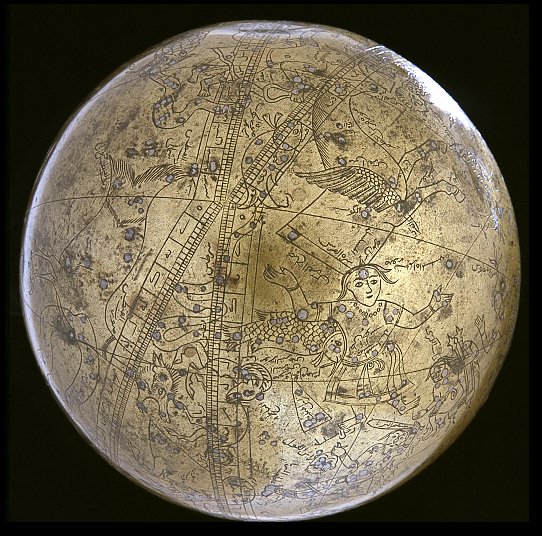
| CLOSE TO THE SUN: |
| 2-27 (73 - 15) |
2-28 |
3-1 (60) |
3-2 |
3-3 |
3-4 |
3-5 |
| MARCH 14 (73) |
15 |
(365 + 75 = 440) |
17 |
18 |
19 |
20 (*364) |
 |
 |
 |
 |
 |
 |
 |
| Gb8-24 |
Gb8-25 (466) |
Gb8-26 |
Gb8-27 |
Gb8-28 |
Gb8-29 |
Gb8-30 (242) |
| MENKHIB (Next to the Pleiades = ζ Persei (57.6) PORRIMA (γ Virginis)
|
ZAURAK (The Boat) = γ Eridani (58.9) |
λ Tauri (59.3), ν Tauri (59.9) |
4h (60.9)
JĪSHUĬ = λ Persei (60.7)
COR CAROLI (α Canum Ven.)
|
υ Persei (61.2) |
BEID (Egg) = ο¹ Eridani (62.2), μ Persei (62.8) VINDEMIATRIX ( ε Virginis) |
Al Dabarān-2 (The Follower) HYADUM I = γ Tauri (63.4) |
| May 17 (137) |
18 (*58) |
19 (*424) |
20 |
21 |
22 |
23 (*428) |
| °May 13 |
14 (*54) |
15 (*420) |
16 (136) |
17 |
18 (*58) |
19 (*424) |
| 'April 20 |
21 (111) |
22 |
23 |
24 |
25 (*400) |
26 (*36) |
| "April 6 |
7 |
Vaitu Nui 8 |
9 (464) |
10 (100) |
11 |
12 (*22) |
| CLOSE TO THE FULL MOON: |
| 8-29 |
8-30 |
8-31 |
9-1 |
(245 = 260 - 15) |
9-3 |
9-4 |
| SEPT 13 |
14 (*177) |
15 |
16 |
(260 = 244 + 16) |
18 |
19 |
| λ Librae (240.0), β Tr. Austr. (240.3), κ Tr. Austr. (240.4), ρ Scorpii (240.8) |
Iklīl al Jabhah-15 (Crown of the Forehead) / Anuradha-17 (Following Rādhā) / Room-4 (Hare)
ξ Lupi, λ Cor. Bor.(241.1), ZHENG = γ Serpentis, θ Librae (241.2), VRISCHIKA = π Scorpii (241.3), ε Cor. Borealis (241.5), DSCHUBBA (Front of Forehead) = δ Scorpii (241.7), η Lupi (241.9) |
υ Herculis (242.3), ρ Cor. Borealis (242.4), ι Cor. Borealis (242.5), θ Draconis (242.6), ξ Scorpii (242.7)
SCHEDIR (α Cassiopeiae)
|
16h (243.5)
ACRAB (Scorpion) = β Scorpii, JABHAT AL ACRAB (Forehead of the Scorpion) = ω Scorpii (243.3), θ Lupi, RUTILICUS = β Herculis (243.5), MARFIK (Elbow) = κ Herculis (243.7), φ Herculis (243.8) |
ψ Scorpii (244.6), LESATH (Sting) = ν Scorpii (244.8) |
χ Scorpii (245.1), YED PRIOR (Hand in Front) = δ Ophiuchi, δ Tr. Austr. (245.5) |
YED POSTERIOR (Hand Behind) = ε Ophiuchi, RUKBALGETHI SHEMALI (Knee, rukbah, of Broken Palm-branch) = τ Herculis (246.6). δ Apodis (246.7), ο Scorpii (246.8) |
|
Lesath was a name both for ν (*244) and for υ (*264) Scorpii, and there were 20 right ascension days from ν to υ.
... Upsilon (uppercase Υ, lowercase υ; Greek: ύψιλον, ýpsilon ... is the 20th letter of the Greek alphabet. In the system of Greek numerals, Υ has a value of 400. It is derived from the Phoenician waw ... Waw (wāw 'hook') is the sixth letter of the Semitic abjads ...
|
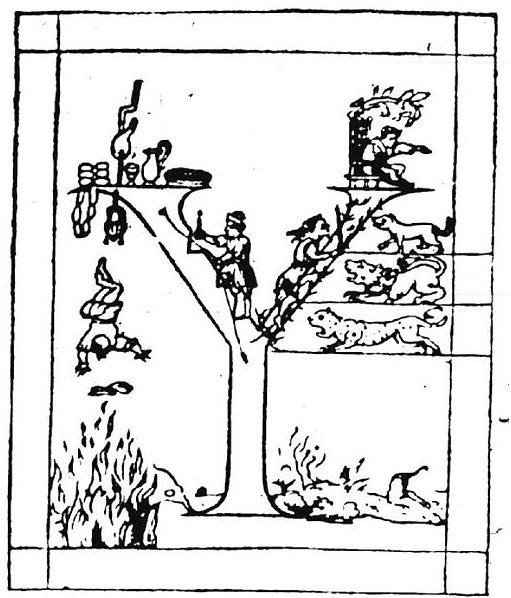
... Upsilon is known as Pythagoras' letter, or the Samian letter, because Pythagoras used it as an emblem of the path of virtue or vice ... |
|
Hora Iti 29 (241) |
46 |
Tangaroa Uri 15 (288) |
14 |
30 (264 + 39) |
|
SPICA (202) |
ANTARES (288 - 39) |
LESATH (264) |
|
48 |
15 |
|
9 weeks |
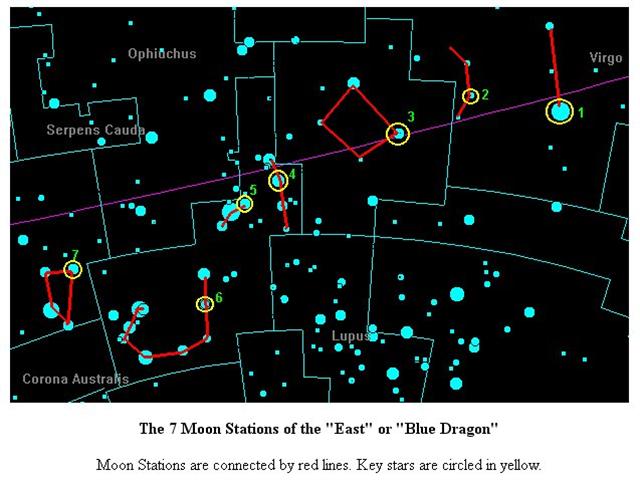

|
| Nov 16 |
17 |
18 (*242) |
19 |
20 |
21 |
22 (326) |
| °Nov 12 (*236) |
13 |
14 |
15 |
16 (*240) |
17 |
18 (322) |
| 'Oct 20 |
21 (*214) |
22 (295) |
23 |
24 |
25 |
26 (299) |
| "Oct 6 |
7 (*200) |
Tangaroa Uri 8 |
9 |
10 |
11 |
12 (285) |
| CLOSE TO THE SUN: |
| 5-17 |
5-18 |
5-19 |
5-20 (140) |
5-21 (*61) |
5-22 |
| JUNE 1 (152) |
2 |
3 |
4 |
5 (156 = 12 * 13) |
6 (*77) |
 |
 |
 |
 |
 |
 |
| Ga3-13 (72) |
Ga3-14 (73) |
Ga3-15 |
Ga3-16 |
Ga3-17 |
Ga3-18 (77) |
| ν Cancri (136.0), TALITHA AUSTRALIS = κ Ursae Majoris (136.1), ω Hydrae (136.8) |
9h (137.0)
σ¹ Ursa Majoris (137.0), κ Cancri (137.3), τ Cancri (137.4), ALSUHAIL (al Wazn, of the Weight) = λ Velorum (137.5), σ² Ursa Majoris (137.6), τ Ursa Majoris (137.7), ξ Cancri (137.8) |
κ Pyxidis (138.0), ε Pyxidis (138.5) |
π Cancri (139.2), MIAPLACIDUS = β Carinae (139.3), TUREIS (Little Shield) = ι Carinae (139.8) |
no star listed (140) |
θ Pyxidis (141.5), MARKAB VELORUM = κ Velorum (141.5), AL MINHAR AL ASAD (The Nose of the Lion) = κ Leonis (141.6), λ Pyxidis (141.9) |
| Aug 4 (216) |
5 |
6 |
7 |
8 (220) |
9 (*141) |
| °July 31 |
°Aug 1 |
2 (214) |
3 |
4 (*136) |
5 |
| 'July 8 |
9 (190) |
10 |
11 |
12 (193) |
13 (*114) |
| ST JOHN'S DAY |
"June 25 (11 * 16) |
26 (177 = 6 * 29½) |
27 |
He Maro 28 |
29 (*100) |
| CLOSE TO THE FULL MOON: |
| 11-16 (320 = 335 - 15) |
11-17 |
11-18 |
11-19 |
11-20 |
11-21 |
| DEC 1 |
2 (336 = 256 + 80) |
3 |
4 |
5 |
6 (*260) |
 |
 |
 |
 |
 |
 |
| Gb1-26 |
Gb2-1 (256 = 16 * 16) |
Gb2-2 |
Gb2-3 (29) |
Gb2-4 |
Gb2-5 (260) |
| 21h (319.6)
ARMUS = η Capricorni(319.0), DORSUM = θ Capricorni (319.3), TSOO = 24 Capricorni (319.7) |
DRAMASA = σ Oct., χ Capricorni (320.0), ν Aquarii (320.3), γ Equulei (320.6), ο Pavonis (320.8) |
α Oct. (321.5), δ Equulei (321.7), φ Capricorni (321.8) |
KITALPHA (Part of a Horse) = α Equulei (322.0), ALDERAMIN (The Right Arm) = α Cephei (322.9) |
DAI = ι Capricorni (323.5), β Equulei (323.8) |
γ Pavonis (324.1), YAN = ζ Capricorni (324.6) |
| Febr 3 (399) |
4 |
5 (401) |
6 |
7 (403) |
8 (*324) |
| °Jan 30 (*315) |
31 (396) |
°Febr 1 |
2 |
3 (399) |
4 (*320) |
| 'Jan 7 (*292) |
8 (373) |
9 |
10 (*295) |
11 |
12 (377) |
| CHRISTMAS EVE |
"Dec 25 |
26 (360) |
27 |
Ko Koró 28 |
(*283 = *260 + *23) |
| CLOSE TO THE SUN: |
| 5-23 (*63) |
5-24 |
5-25 (5 * 29) |
5-26 (146 = 2 * 73) |
5-27 |
5-28 (*68) |
| JUNE 7 (*78) |
8 |
9 |
10 (161) |
11 |
12 |
 |
 |
 |
 |
 |
 |
| Ga3-19 |
Ga3-20 → 320 |
Ga3-21 (80) |
Ga3-22 |
Ga3-23 |
Ga3-24 |
| The Knot (Ukdah) |
Rishu A.-13 (Head of the Lion)
ψ Leonis (146.4), RAS ELASET AUSTRALIS = ε Leonis (146.6) |
VATHORZ PRIOR = υ Carinae (147.9) |
| Star-25 (Horse) / ANA-HEU-HEU-PO-5 (Pillar where debates were held) ALPHARD (Horse) = α Hydrae (142.3), ω Leonis (142.6), τ¹ Hydrae (142.7) |
Al Tarf-7 (The End)
ψ Velorum (143.3), ALTERF (The End) = λ Leonis, τ² Hydrae (143.4), ξ Leonis (143.5) |
A Hydrae (144.1)
VEGA (α Lyrae)
|
UKDAH (Knot) = ι Hydrae (145.4), κ Hydrae (145.5), SUBRA = ο Leonis (145.8)
*104 = *145.4 - *41.4 |
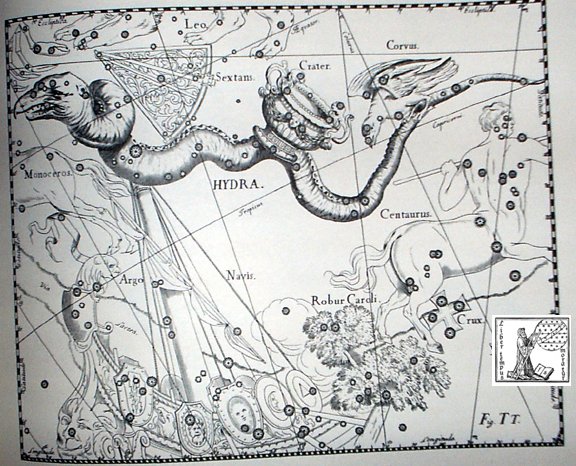 |
| Aug 10 |
11 |
12 |
13 (*145) |
14 |
15 (227 → π) |
| °Aug 6 |
7 |
8 (220) |
9 |
10 |
11 (*143) |
| 'July 14 |
15 |
16 |
17 (*118) |
18 |
19 (200) |
| SIRIUS (181) |
"July 1 |
2 (79 + 104) |
3 (*104) |
4 |
He Anakena 5 |
|
... They stayed (there longer). On the fifth day of the month of July (Anakena) [day 186 + 41 = 227], they all got up, went downhill, went on, and reached Hanga Te Pau. They took their provisions with them, carrying them on their shoulders, went on, and reached Te Pou. They made camp and slept in Te Pou on the tenth of the month of July (Anakena). Then they all got up, carried their provision on their shoulders, went straight ahead, and followed the path of the dream soul of Hau Maka. They came to Hua Reva and said, This is Hua Reva A Hau Maka!... |
| CLOSE TO THE FULL MOON: |
| 11-22 |
11-23 |
11-24 |
11-25 (329) |
11-26 (*250) |
11-27 |
| *261 (= 9 * 29) |
8 |
9 |
10 |
11 (345) |
DEC 12 (*266) |
 |
 |
 |
 |
 |
 |
| Gb2-6 (32) |
Gb2-7 |
Gb2-8 |
Gb2-9 |
Gb2-10 (229 + 36) |
Gb2-11 (266) |
| BUNDA (Foundation) / KAKKAB NAMMAΧ (Star of Mighty Destiny) |
θ Piscis Austrini (330.1), λ Oct. (330.7) |
| Al Sa'd al Su'ud-22 (Luckiest of the Lucky) / Emptiness-11 (Rat)
TSIN = 36 Capricorni (325.2), ALPHIRK (The Flock) = β Cephei (325.7), SADALSUD = β Aquarii, ξ Gruis (325.9) |
no star listed (326) |
CASTRA = ε Capricorni (327.2), BUNDA = ξ Aquarii (327.5)
SIRIUS (α Canis Majoris)
|
Mahar sha hi-na Shahū-26 (Western One in the Tail of the Goat)
NASHIRA = γ Capricorni (328.0), ν Oct. (328.3), AZELFAFAGE = π¹ Cygni, κ Capricorni (328.7) |
Arkat sha hi-na Shahū-27 (Eastern One in the Tail of the Goat)
ENIF (The Nose) = ε Pegasi, ERAKIS = μ Cephei (329.2), 46 CAPRICORNI, JIH (the Sun) = κ Pegasi (329.3), ι Piscis Austrini (329.4), λ Capricorni (329.6), ν Cephei (329.7), DENEB ALGIEDI (Tail of the Goat) = δ Capricorni (329.8) |
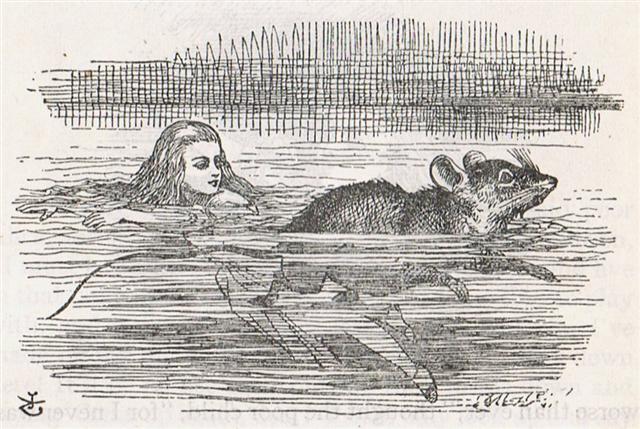
... In China, with Capricornus, Pisces, and a part of Sagittarius, it [Aquarius] constituted the early Serpent, or Turtle, Tien Yuen; and later was known as Hiuen Ying, the Dark Warrior and Hero, or Darkly Flourishing One, the Hiuen Wu, or Hiuen Heaou, of the Han dynasty, which Dupuis gave as Hiven Mao. It was a symbol of the emperor Tchoun Hin, in whose reign was a great deluge; but after the Jesuits came in it became Paou Ping, the Precious Vase. It contained three of the sieu, and headed the list of zodiac signs as the Rat, which in the far East was the ideograph for 'water', and still so remains in the almanacs of Central Asia, Cochin China, and Japan ... |
|
... On February 9 the Chorti Ah K'in, 'diviners', begin the agricultural year. Both the 260-day cycle and the solar year are used in setting dates for religious and agricultural ceremonies, especially when those rituals fall at the same time in both calendars. The ceremony begins when the diviners go to a sacred spring where they choose five stones with the proper shape and color. These stones will mark the five positions of the sacred cosmogram created by the ritual. When the stones are brought back to the ceremonial house, two diviners start the ritual by placing the stones on a table in a careful pattern that reproduces the schematic of the universe. At the same time, helpers under the table replace last year's diagram with the new one. They believe that by placing the cosmic diagram under the base of God at the center of the world they demonstrate that God dominates the universe. The priests place the stones in a very particular order. First the stone that corresponds to the sun in the eastern, sunrise position of summer solstice is set down; then the stone corresponding to the western, sunset position of the same solstice. This is followed by stones representing the western, sunset position of the winter solstice, then its eastern, sunrise position. Together these four stones form a square. They sit at the four corners of the square just as we saw in the Creation story from the Classic period and in the Popol Vuh. Finally, the center stone is placed to form the ancient five-point sign modern researchers called the quincunx ... |
All Hearts' Day |
| NORTH-EAST |
NORTH-WEST |
SOUTH-WEST |
SOUTH-EAST |
 |
| Febr 9 (40) |
10 |
11 |
12 (408) |
(*329 - *87 = 11 * 27) |
| °Febr 5 |
6 |
7 |
8 (*324) |
(13 * 25 = *325) |
10 (41) |
| 378 = 365 + 13 |
'Jan 14 |
15 (*300) |
16 |
17 |
18 (383) |
| "Dec 30 |
Ko Koró 31 |
"Jan 1 |
2 |
3 (368) |
Tua Haro 4 |
| 43 |
CLOSE TO THE SUN: |
| 7-11 |
7-12 |
7-13 |
7-14 (*115) |
7-15 (196) |
| JULY 26 (*127) |
27 |
28 |
29 (210) |
30 |
 |
 |
 |
 |
 |
| Ga5-17 |
Ga5-18 (128) |
Ga5-19 |
Ga5-20 |
Ga5-21 |
|
Al Áwwā'-11 (The Barker) / Shur-mahrū-shirū-18 (Front or West Shur)
Sombrero Galaxy = M104 Virginis (191.1), ρ Virginis (191.4), PORRIMA = γ Virginis, γ Centauri (191.5)*191.4 - *41.4 = *150 |
ι Crucis (192.2), β Muscae (192.5), MIMOSA = β Crucis (192.9) |
no star listed (193) |
κ Crucis (194.4), ψ Virginis (194.5), μ Crucis, λ Crucis (194.6), ALIOTH (Fat Tail) = ε Ursae Majoris, ι Oct. (194.8) |
MINELAUVA = δ Virginis (195.1), COR CAROLI = α Canum Ven. (195.3) |
| Sept 28 |
29 (*192) |
30 (273) |
Oct 1 |
2 |
| °Sept 24 |
25 (*188) |
26 |
27 (270) |
28 |
| 'Sept 1 |
2 (*165) |
3 |
4 |
5 (248) |
| "Aug 18 (*150) |
19 (231) |
Hora Iti 20 (*152) |
21 |
22 |
| OROMANGA (*125 - *151) |
PAPA O PEA (*152 - *156) |
|
... He (i.e., Ira) said, 'Let's go! We shall go to Papa O Pea'. They all got up and moved on. On the twentieth day of the month of August ('Hora Iti') they went to Papa O Pea. They all went and came to Papa O Pea, looked around in Papa O Pea, and gave the name 'Papa O Pea A Hau Maka'. They stayed five days in Papa O Pea ...
Pea. (Also peapea): To go away with bits of food or mud sticking to one's face or garments. Vanaga. Peaha, perhaps ... maybe, chance, doubtful; reoreo peaha ... Ma.: pea, perhaps. Peapea, an erasure ... hakapeapea ... Peau, to sweep all away. Ma.: peau, to be turned away. Churchill. Peau, a wave (Sa., To., Fu., Fotuna, Niuē, Mq., Nuguria); Mgv.: peau, peahu, id. Churchill 2.
... But in the fullness of time an obscure instinct led the eldest of them towards the anthill which had been occupied by the Nummo. He wore on his head a head-dress and to protect him from the sun, the wooden bowl he used for his food. He put his two feet into the opening of the anthill, that is of the earth's womb, and sank in slowly as if for a parturition a tergo. The whole of him thus entered into the earth, and his head itself disappeared. But he left on the ground, as evidence of his passage into that world, the bowl which had caught on the edges of the opening. All that remained on the anthill was the round wooden bowl, still bearing traces of the food and the finger-prints of its vanished owner, symbol of his body and of his human nature, as, in the animal world, is the skin which a reptile has shed ... |
| CLOSE TO THE FULL MOON: |
| 1-9 (74 + 300) |
1-10 |
1-11 (2 * 188) |
1-12 (377) |
1-13 |
| JAN 24 |
25 |
26 |
27 (392) |
28 |
| ξ Phoenicis (9.0), ρ Tucanae (9.1), DENEB KAITOS (Tail of the Sea Beast) = β Ceti, η Phoenicis (9.4), AL NITHĀM (String of Pearls) = φ¹ Ceti (9.6) |
ACHIRD (Woman with Luminous Rays) = η Cassiopeiae (10.7) |
Legs-15 (Wolf)
ν Andromedae (11.0), φ² Ceti (11.1), ρ Phoenicis (11.2), Η Andromedae (11.4) |
CIH (Whip) = γ Cassiopeiae, λ Tucanae (12.4), φ³ Ceti (12.6), μ Andromedae (12.8)
*12.4 + *365 - *41.4 = *336 (= 4 * 84) |
φ4 Ceti (13.2) |
|
... At the beginning of 44 B.C. - when Ceasar was still alive - the Senate decided to raise statues of him in all the temples and to sacrifice to him on his birthday in the month Quintilis, which in honour of him was renamed July. He was raised to the status of a god (among the other gods of the state) under the name Jupiter Julius. Marcus Antonius, who this year was consul together with Ceasar, became high priest and responsible for the ceremonies. In the middle of February, at the time of the old feast of Lupercalia [cfr Lupus = Wolf], he ran around naked and whipped the Roman ladies with thongs made from goat-skin [februa], in order to promote their fertility ... |
| March 30 |
31 (*375) |
April 1 (91 = 456) |
2 |
3 |
| °March 26 |
27 |
28 (*372) |
29 (88) |
30 |
| 'March 3 |
4 |
5 (64) |
6 (*350) |
7 |
| "Febr 17 |
18 |
19 (50) |
Tehetu'upú 20 (*336) |
21 |
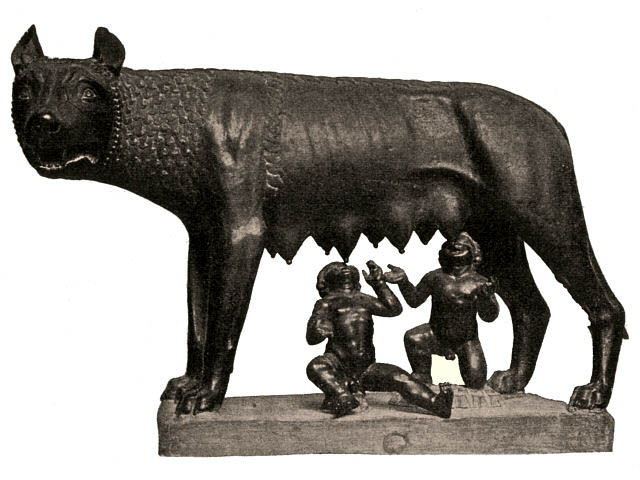 |
| CLOSE TO THE SUN: |
| 7-16 |
7-17 |
7-18 |
7-19 (200) |
7-20 |
7-21 |
7-22 → π |
| JULY 31 |
AUG 1 |
2 (214) |
(*135 = 500 - 365) |
4 (*136) |
5 |
6 |
 |
 |
 |
 |
 |
 |
 |
| Ga5-22 |
Ga5-23 |
Ga5-24 |
Ga5-25 (135) |
Ga5-26 |
Ga5-27 (→ 364) |
Ga5-28 |
| δ Muscae (196.5) , VINDEMIATRIX (Grape Gatherer) = ε Virginis (196.8) |
13h (197.8)
ξ¹ Centauri (197.1), ξ² Centauri (197.9) |
APAMI-ATSA (Child of Waters) = θ Virginis, ψ Hydrae (198.5), DIADEM = α Com. Ber. (198.9) |
AL DAFĪRAH (Tuft) = β Com. Ber. (199.4) |
σ Virginis (200.4) |
γ Hydrae (Al Dhanab al Shuja) (201.0), ι Centauri (201.4) |
Al Simāk-12 (Lofty) / Chitra-14 (Bright One) / Horn-1 (Crocodile) / Sa-Sha-Shirū-20 (Virgin's Girdle) / ANA-ROTO-3 (Middle pillar)
MIZAR = ζ Ursae Majoris (202.4), SPICA = α Virginis, ALCOR = 80 Ursae Majoris (202.7)
SADALMELIK (α Aquarii)
*161 = *202.4 - 41.4 |
| Oct 3 |
4 (277) |
5 |
6 |
7 (*200) |
8 |
9 (282) |
| °Sept 29 |
30 |
°Oct 1 |
2 (275) |
3 (*196) |
4 |
5 |
| 'Sept 6 |
7 (250) |
8 |
9 |
10 |
11 |
12 (*175) |
| "Aug 23 |
24 (236) |
25 |
Hora Iti 26 |
27 |
28 (240) |
Hora Iti 29 |
|
Ahu. 1. Funerary monument with niches holding the skeletons of the dead. 2. Generic term for a grave, a tomb merely enclosed with stones. 3. Stone platform, with or without graves. 4. Elevated seat, throne. 5. Swollen; to swell up: ku-ahu-á tooku va'e, my foot is swollen; ananake te raá e-tagi-era te ûka riva mo toona matu'a ka-ahu ahu-ró te mata, every day the daughter cried for her parents until her eyes were quite swollen. Vanaga.
1. To transfer, to transplant, to take up by the roots. 2. To puff up, to swell, a swelling, protuberance; gutu ahu, swollen lips; ahuahu, to swell, plump, elephantiasis, dropsy; ahuahu pupuhi, amplitude; manava ahuahu, indigestion. 3. Paralysis. 4. A carved god of dancing, brought forth only on rare occasions and held of great potency. Ahuahu, inflammation. Ahukarukaru (ahu 2 - karukaru), dropsy. Churchill. |
Ahu Akapu
(2 days) |
Aka. 1. Anchor: he-hoa te aka, to drop anchor. 2. Root of certain plants (banana tree, taro, sugar-cane). 3. To be paralyzed by surprise. Vanaga.
1. Root; aka totoro, to take root. P Pau., Mq.: aka, root. Ta.: aa, id. 2. (āka) anchor. 3. Causative (haka). Churchill. |
Pu Pakakina
(1 month) |
| CLOSE TO THE FULL MOON: |
| 1-15 |
1-16 |
1-17 |
1-18 |
1-19 (384) |
1-20 |
1-21 |
| JAN 30 |
31 (396) |
FEBR 1 (32) |
2 |
3 |
4 (*320) |
5 (36) |
| PAPA O PEA |
Al Batn Al Hūt-26 (Belly of the Fish) / Revati-28 (Prosperous) / 1-iku (Field Measure)
MIRACH (Girdle) = β Andromedae, KEUN MAN MUN (Camp's South Gate) = φ Andromedae (16.0), ANUNITUM = τ Piscium (16.5), REVATI (Abundant) = ζ Piscium (16.9)
REGULUS (α Leonis)
|
... On the twenty-sixth day of the month of August ('Hora Iti') they went from Papa O Pea to Ahu Akapu. They all went and reached Ahu Akapu. They looked around and gave the name 'Ahu Akapu A Hau Maka'. They also saw (all of) Te Pito O Te Kainga, looked around, and gave (the whole island) the name 'Te Pito O Te Kainga A Hau Maka'. [E:31] They made camp and rested at Ahu Akapu for two days. On the twenty-ninth day of the month of August ('Hora Iti') they went to Pu Pakakina. They arrived, remained there, and gave the name 'Pu Pakakina A Ira'. They remained one month in Pu Pakakina. |
| no star listed (14) |
1h (15.2)
β Phoenicis (15.1), υ Phoenicis, ι Tu canae (15.6), η Ceti, ζ Phoenicis (15.7) |
ν Phoenicis (17.4), κ Tucanae (17.6) |
no star listed (18) |
ADHIL (Garment's Train) = ξ Andromedae (19.3), θ Ceti (19.7) |
KSORA (Knee) = δ Cassiopeiae (20.1), ω Andromedae (20.6), γ Phoenicis (20.8) |
| April 4 |
5 (460 = 396 + 64) |
6 |
7 |
8 (13 * 29½ - ½) |
9 (*384) |
10 (100) |
| °March 31 |
°April 1 (91) |
2 (*377) |
3 |
4 |
5 (460 = 396 + 64) |
6 (*16) |
| 'March 8 |
9 |
10 (*354) |
11 |
12 |
13 (72) |
14 → π |
| Tehetu'upú 22 |
TERMINALIA |
"Febr 24 (420) |
25 |
26 |
27 (*7 * 7 * 7) |
28 (59) |
|
... The leap day was introduced as part of the Julian reform. The day following the Terminalia (February 23) was doubled, forming the bis sextum - literally 'double sixth', since February 24 was 'the sixth day before the Kalends of March' using Roman inclusive counting (March 1 was the 'first day'). Although exceptions exist, the first day of the bis sextum (February 24) was usually regarded as the intercalated or 'bissextile' day since the third century. February 29 came to be regarded as the leap day when the Roman system of numbering days was replaced by sequential numbering in the late Middle Ages ... |
Then followed Pu Pakakina, at the beginning of the Blue Dragon, viz. at Spica, which thus in a way also could be named Te Pou, as the Pillar or the Leader of the last part of the year:
| BLUE DRAGON: |
| 1 |
Horn |
α Virginis (Spica) |
Crocodile |
(202.7) |
Oct 9 (282 = 472 - 190) |
| 2 |
Neck |
κ Virginis |
Dragon |
(214.8) |
Oct 21 (294) |
| 3 |
Root |
α Librae (Zuben Elgenubi) |
Badger |
(224.2) |
Oct 31 (304) |
| 4 |
Room |
π Scorpii (Vrischika) |
Hare |
(241.3) |
Nov 17 (321) |
| 5 |
Heart |
σ Scorpii |
Fox |
(247.0) |
Nov 23 (327) |
| 6 |
Tail |
μ Scorpii (Denebakrab) |
Tiger |
(254.7) |
Nov 30 (334) |
| 7 |
Winnowing Basket |
γ Sagittarii (Nash) |
Leopard |
(273.7) |
Dec 19 (353) |
At the time of rongorongo Sirius stood like a pillar at day zero in June 30, 181 (*101), and 101 days later came Spica in October 9, 282 (*202). The flag of Brazil has uplifted Spica with a little dot far down marking Dramasa (σ Octantis, the South Pole star). In between we can perceive the Southern Cross, and between Spica and the Southern Cross is the Tail of the Hydra (γ Hydrae, Al Dhanab al Shuja) - in the day before Spica but below the curved band. To the right is the Scorpion with Antares placed at the opposite side compared to Procyon (α Canis Minoris), below O in ORDEM. Alphard (α Hydrae) is below M. Sirius and 4 more stars in Canis Major are noted below Alphard, together with Canopus. In addition to 8 stars in the Scorpion we can also see 3 more stars to the left which mark the Southern Triangle (Triangulum Australe). Altogether there are 26 + 1 = 27 stars:
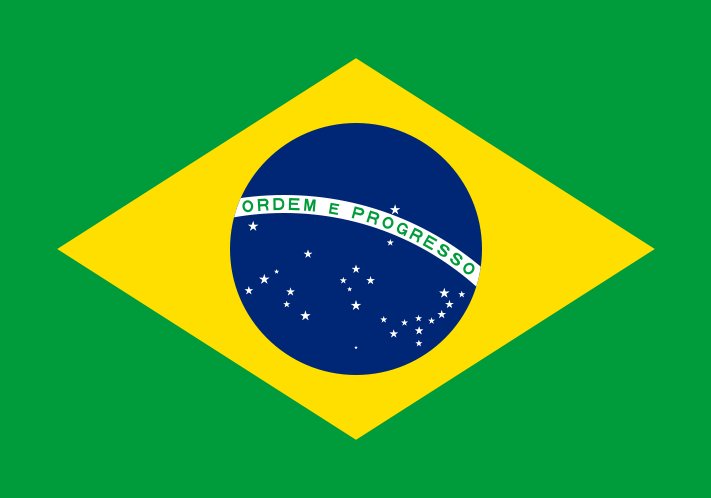

... The stars, whose position in the flag reflect the sky over Rio de Janeiro on November 15, 1889, represent the union's federated units - each star representing a specific state ... On May 12, 1992, the flag was modified with the addition of six stars to the celestial globe - representing the newly created states, and a slight change in the stars' positions was made to match the astronomical coordinates correctly ...
... There are at present 26 states in Brazil, each of them represented by a star in the coat of arms:
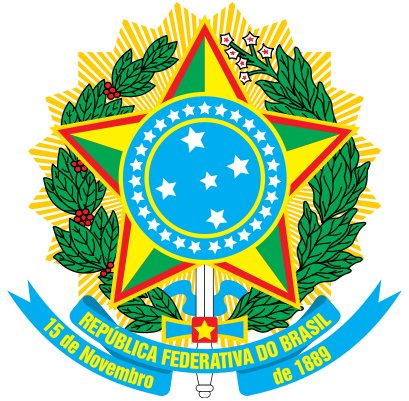
A 27th star represents the Federal district and the 5 great stars in the center of the circle (like a quincunx) could, I guess, illustrate the regions; Northern, Northeast, Central-West, Southeast and Southern ...
At the time of Bharani the Tail of the Hydra (γ Hydrae) was in day 240 (= 8 * 30) counted from "January 1. Allen:
"The stars between Corvus and Crater were Kien Mun, and those between γ Hydrae and Spica of the Virgin were Tien Mun, Heaven's Gate ... Hydra is supposed to be the snake shown on a uranographic stone from the Euphrates, of 1200 B.C., 'identified with the source of the fountains of the great deep', and one of the several sky symbols of the great dragon Tiāmat. Certain stars near, or perhaps in the tip of the Hydra's tail and in Libra, seem to have been the Akkadian En-te-na-mas-luv, or En-te-na-mas-mur, the Assyrian Etsen-tsiri, the Tail-tip ...
For an unknown period its winding course symbolized that of the moon; hence the latter's nodes are called the Dragon's Head and Tail. When a comet was in them poison was thought to be scattered by it over the world; but these fanciful ideas are now associated with Draco."
Anciently the Blue Dragon had been far down but the precession had moved Spica forward in the year and nowadays the creature was oriented vertically:
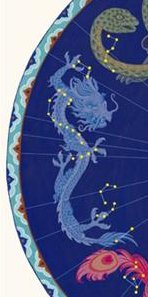
It looks like the Mayan map with an alligator (Moon) on one side of the Tree with a Sun (fire) person in the east, trampling hard with his foot on the nose of the croc to make it go away - though at the same time loosing his right hand (of course) to Ursa Major (Seven Macaw, Itzam Yeh):
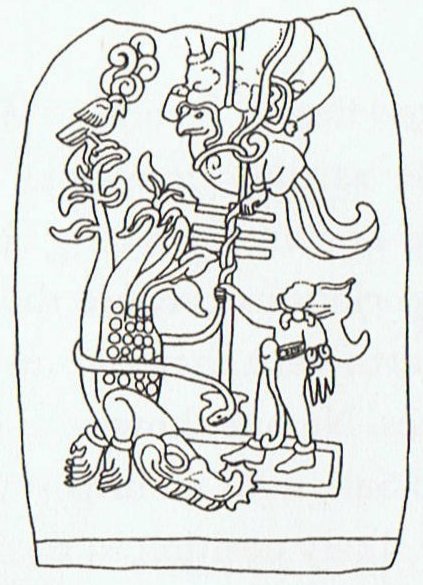
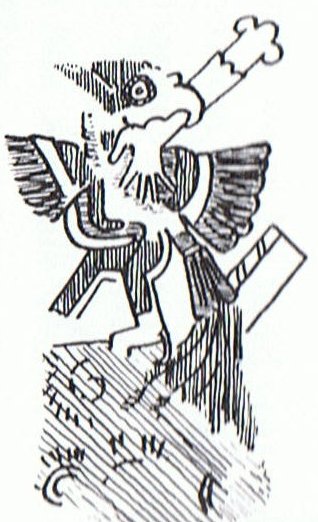

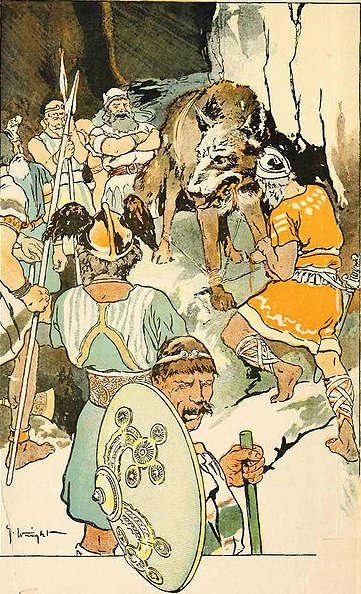
The Maya texts are running from right to left and the Dragon (Alligator) should come later than the Sun person, which we will see in a mirror: 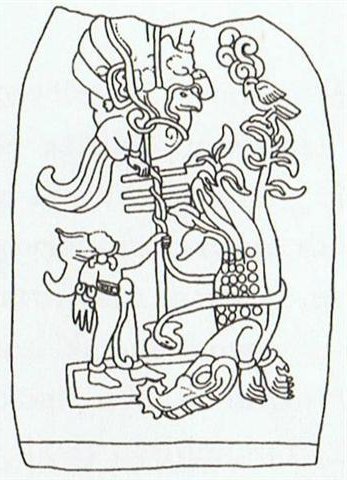
|































